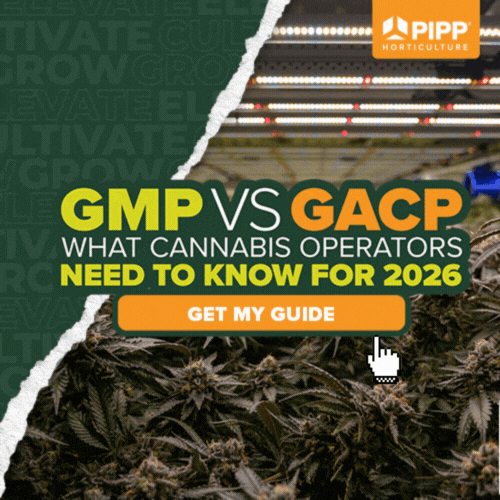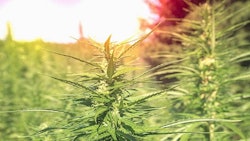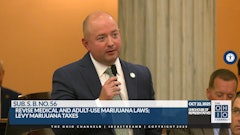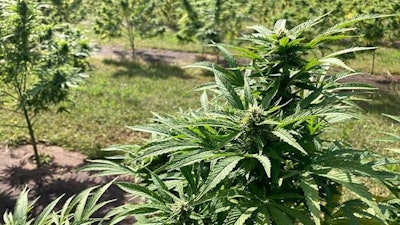
A dirt road winds back into a 250-acre property in rural Kelloggsville, Ohio—the northeast corner of the state—past farm equipment and natural flora. In a fenced 2-acre section of the property, surrounded by forest on three sides and an open expanse on the fourth, David and Deidre Snyder grow their cannabinoid hemp. It’s a sunny afternoon in September, and they’re hand-trimming White CBG (cannabigerol) flower, storing it in a large bin.
It’s clear that manicuring the large, frosty buds requires care and effort, but, Deidre explains and exhibits, the hangers-on further down the stems get tossed. She's the master trimmer, David admits, though she humbly states she's just been helping him out on the farm. Both of them are intimately familiar with the environment, such as the glacial moraine they're growing on and using for groundwater, mice's affinity for eating the younger but not the more mature hemp plants, and how the clouds move above the treeline. They're dialed in and focus on quality, not quantity, at their operation, Lost River Farm.
The Snyders grew 1,000 hemp plants in 2021. As of press time, they were finishing up a successful growing season with 750 Topaz CBD plants and 250 White CBG plants, mostly for smokable flower and some set to go to extraction. But they say they’d grow half as many plants if the state allowed fewer than the mandated 1,000.
"If you have your crop and you're able to go through it every day and look for problems, such as caterpillars and certain bugs, and be able to pull that leaf off and trim the lower branches off—and tend to your plant—you will have a very nice yield," Deidre says.
In 2020, the Snyders’ first year farming hemp, they grew 500 more plants than in 2021. That downsizing tracks with broader state figures. Ohio’s hemp program was established following the passage of the Agriculture Improvement Act of 2018 (the 2018 Farm Bill), and growers planted their first crops in 2020, but the market has already seen some contractions since then.
Acreage figures and the total number of growers are both down from last year. And this year’s growers by and large have not come close to fulfilling their planned licensed acreage. In 2020, 195 growers were licensed to plant 2,067 acres but ended up growing on only 491 acres, according to Ohio Department of Agriculture (ODA) data. In 2021, 179 growers licensed 1,498 acres and planted on only 272 of those, per ODA.
| Ohio's Hemp Industry by the Numbers: 2021 |
| 179 entities registered as hemp cultivation locations |
| 1,498 acres registered to cultivate hemp |
| 272.01 acres planted |
| 53 processors |
| 574,775 outdoor floral plants on 227.733 acres |
| 260,795 indoor floral plants |
| 30,699,680 outdoor fiber/grain plants on 44.966 acres |
Source: Processor information provided by the ODA and updated as of Oct. 5, 2021; Rest of data provided by ODA on Aug. 26, 2021
Ohio is a large farming state, with most of its production focused on corn and soybeans, according to the U.S. Department of Agriculture (USDA). In 2020, Ohio ranked 14th among states with the highest agricultural receipts—or cash income produced by commodity sales—per the agency.
This year, more than 227 outdoor acres of Ohio’s 272 total acres of hemp were dedicated to “floral plants,” according to ODA. (Another 260,795 floral plants were grown indoors.) However, hemp fiber and grain farmers reported to the agency that they planted a whopping 30.7 million plants on just 44.96 acres. And when asked if existing farm infrastructure could be used for grain processing, ODA Hemp Program Director David Miran said, “[U]se of this infrastructure has been demonstrated at various field trials across the country.” ODA just has not seen it firsthand, he added.
Adjustments and Learning Curves
For the Ohio farmers Hemp Grower spoke with, the pros of growing have outweighed the cons, though it hasn’t been easy.
The Snyders say one challenge has been the 15-day window Ohio allots to growers between the date the state collects samples and the planned harvest date. This is on par with the USDA interim final rule but more stringent than the 30-day window allowed by the USDA final rule, which took effect in March.
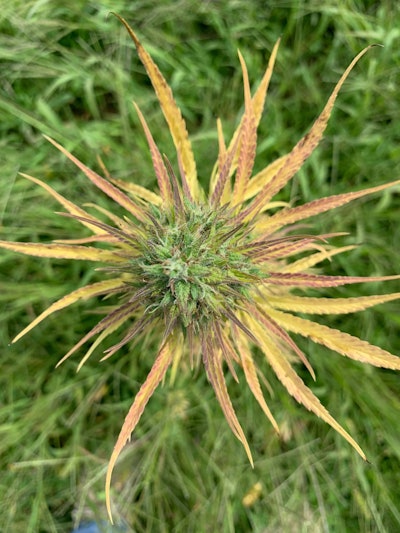
While navigating some of these difficulties—including sampling costs and timelines, a rainy July and caterpillars (which they control with nematodes early in the season and then by hand)—David says he and Deidre are looking ahead to growing their customer base for smokable hemp, tinctures and kief via smoke shops, e-commerce and advertising their product at events.
In Montville Township, Ohio—also in the Northeast region of the state, southwest of Kelloggsville and east of Cleveland—Dawn Brace and her family brought previous farming experience to hemp.
Dawn, a local real estate agent, her husband, CEO James W. Brace, a heavy equipment operator, and their son, Jonathan Brace, a Berry College biochemistry graduate, make up Hemp & Honey. The family-run operation leases property for 1 acre of hemp production, but has also tapped maple syrup from more than 400 trees on a 60-acre property that James’ family owns and where he used to grow hay.
In 2021, their first year growing hemp, they planted 1,000 hemp plants—500 of the Golden Kush CBD cultivar and 500 of the Serenity CBG variety for smokable flower and extraction, says Dawn, operations field manager. (They also began beekeeping this year, hence the business name.)
They sowed their first plants in a small greenhouse, then transplanted them into the field once they grew to about 6 to 8 inches tall, Dawn says. Early on, a heavy rainstorm hit, and deer came onto the property and devoured 10 to 15 plants, she says, adding, "Once we first planted, they investigated everything, and then they never came back and ate anything else."
Long-lasting Ohio winters can also complicate planning and planting. Every year, disproportionate amounts of lake-effect snow fly upon the “snowbelt,” a target of Great Lakes winter-weather systems that stretches across multiple states and includes parts of Northeast Ohio.
In Montville Township, it snows well into spring. This year, the business was fortunate, because the weather was warm for planting in May. “It was 90 [degrees] that week,” Dawn says. “That’s very unusual.”
Storms, snow, deer, heavy winds—these are things that just come with the territory.
“For our first year, I am very impressed with what we’ve done,” Dawn says. “We would have liked to have [the plants] a little bit taller. I think they adapted due to the wind, and they just stayed short and stout. But otherwise, they’re good.”
Not Immune to Industry Growing Pains
After growing and harvesting, selling hemp can prove especially difficult anywhere across the U.S. It’s no different in Ohio, says Benjamin Moidell, partner and CEO at Chagrin Valley Hemp Company (CVHC), a hemp processor, extractor and manufacturer. “Unfortunately, it’s currently a race to the bottom due to the oversupply of hemp material both in Ohio and across the country,” he says.
When asked if there have been any drawbacks for hemp growers in Ohio so far, Miran told Hemp Grower there have been issues, but they aren’t specific to the state. He noted there’s been a nationwide overproduction of hemp crops, adding that growers should secure contracts before they plant.
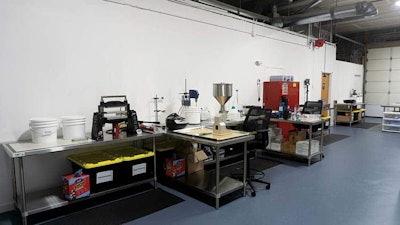
Moidell’s business is roughly 2,100 square feet with a 1,500-square-foot main production floor. He works with a handful of growers and about 40 retailers in the state. “To hear growers are struggling—to have them contact us and want to give us their material so that they can make space in their barn—is heartbreaking,” Moidell says.
Miran says the state was one of the first to have an operational plan approved by the USDA following the passage of the 2018 Farm Bill. But, he says, “hemp is still a new industry in Ohio. The program will continue to grow and change as we learn more about producing the crop.”
CVHC sources hemp flower material from Ohio growers. Meanwhile, the company sources CBD and CBG distillate, along with CBD, CBG and cannabinol (CBN) isolate, from outside the state. CVHC has also diversified its own business by capitalizing on delta-8 THC product formulation. It ships in the delta-8 distillate from across state lines, primarily from Colorado.
The ODA does not require growers to conduct post-harvest testing, according to the agency’s website. However, when hemp product is under processor control, Ohio law requires testing laboratories to sample any hemp product for various criteria, such as potency, “[m]icrobial contaminants of public health concern,” mycotoxins, heavy metals and pesticides, before sale.
Testing can be surprisingly expensive for growers who are trying to sell material to licensed Ohio processors, Moidell says. “In order for us to support them and purchase their material and mitigate our risk as a business, we require that it’s shown that the material is compliant to the processing requirements prior to purchase,” he says.
Ohio hemp processors must follow the same standards as any food manufacturer in the state, Miran says, adding that processors’ adherence to safety and sanitation requirements provides end consumers with confidence when they purchase hemp products.
Growers, too, are hopeful they’ll be able to garner positive attention with their products while tending to valuable land.
“There’s a lot of farmland up here that just sits,” Dawn says. “Rather than it being sold and developed, let’s do something with it.”
Editor's note: An abbreviated version of this story ran in the October issue of Hemp Grower magazine.

